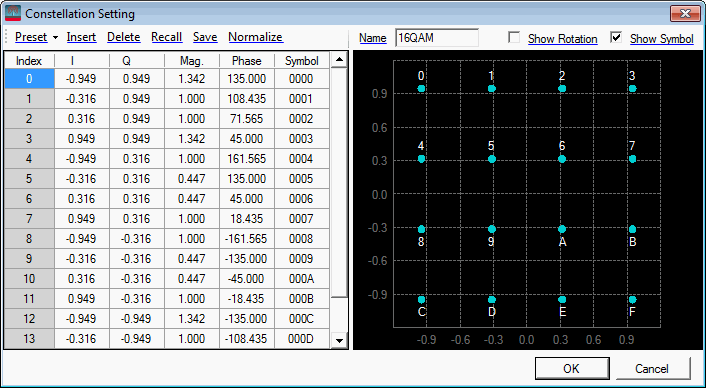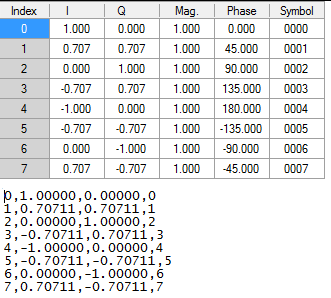
This window appears when you click the Constellation cell for a Custom IQ data segment. Use it to make edits to the constellation and individual symbols.

Choices: OOK | 2ASK | 4ASK | 8ASK | BPSK | QPSK | 8PSK | 16QAM | 32QAM | 64QAM | 128QAM | 256QAM | 512QAM | 1024QAM | 2048QAM | 4096QAM | 8192QAM | 16384QAM
Use the drop-down menu to select a pre-defined modulation type.
Inserts a new constellation symbol below the selected row with a default setting of zero for all parameters.
Deletes the selected constellation symbol.
Recall a text file of constellation symbols. Each line in the text file represents a symbol state defined in the constellation. The values for each symbol should be separated with commas and include Index , I (real) , Q (imaginary) , and Symbol in that order. Magnitude and phase are not included, as they are calculated from the I and Q values. This ![]() image shows the symbols for an 8PSK constellation as they appear in both the software and the text file. You can also generate this type of file with other tools, such as Matlab.
image shows the symbols for an 8PSK constellation as they appear in both the software and the text file. You can also generate this type of file with other tools, such as Matlab.
Save the current symbol constellation to a text file for recall. Each line in the text file represents a symbol state defined in the constellation. The values for each symbol are separated with commas and include Index , I (real) , Q (imaginary) , and Symbol in that order. Magnitude and phase values are not saved, as they are calculated from the I and Q values. This ![]() image shows the symbols for an 8PSK constellation as they appear in both the software and the text file. You can also generate this type of file with other tools, such as Matlab.
image shows the symbols for an 8PSK constellation as they appear in both the software and the text file. You can also generate this type of file with other tools, such as Matlab.

Rescales all the constellation states to achieve an RMS value of 1.
Allows you to rename the constellation. This name will also appear in the Constellation column of the segment list.
Shows the Phase Rotation in the graphical display of the constellation (video).
Shows the symbol number in the graphical display of the constellation.